
Direct Email Marketing: Definition, How to & Best Practices [2025]
Ever wonder why direct email marketing gets so much attention?
It’s not just another strategy—it’s a game-changer, especially for eCommerce businesses. If you’re struggling with low sales, weak customer connections, and getting lost in the digital noise, direct emails can transform these pain points into opportunities.
In this guide, we’re going to break down why you should consider direct email marketing and how it can transform your business. We’ll dive into the benefits, from increased brand loyalty to higher conversion rates.
You’ll also learn how to craft direct email campaigns, measure their success, and discover some top best practices to drive customer action.
What Is Direct Email Marketing?
Direct email marketing is a digital marketing strategy through which you send personalized offers to pre-selected subscribers via email.
While it may sound like email marketing, direct email marketing takes a different approach.
Email marketing entails sending mass promotional emails to people to educate, inform, or direct them to take a desired action.
Direct email marketing, on the other hand, offers a more personalized approach. So, instead of sending generic emails to your entire contact list, you send customized emails to a select few.
Here’s a simple example of Michael Kors’ loyalty program, promoting an exclusive summer perk only to KORSVIP members:

In addition, be careful not to confuse direct email marketing with direct mail marketing. The latter refers to sending promotional materials to potential customers via mail. So, it’s a completely different type of marketing.
If you’re thinking of using it, it’s good to know that direct mail campaigns are considered a thing of the past, and potential customers may see them as spam and throw them away.
Plus, you can’t measure their performance and target the recipients with follow up campaigns based on their actions.
Are Direct Email Marketing Campaigns Effective?
The answer is yes—direct email marketing campaigns can be very effective if used properly.
Even though they share most of the general email marketing benefits, the personal touch that direct emails bring to the table can make a big difference.
According to HubSpot’s State of Marketing & Trends Report, 96% of marketers note that personalized emails promote repeat business, and 94% have noticed an increase in sales.
Still, just like any other digital marketing strategy, direct email marketing has pros and cons that you should be aware of. Here are some of them:
Pros
- Boosting email marketing metrics (e.g., open rate, conversion rate, etc.)
- Developing closer, long-lasting customer relationships
- Increasing brand awareness
- Building customer loyalty
- Driving more sales
- Offering great email ROI
Cons
- Can be perceived as spammy
- Potential for email fatigue
- Limited targeting options
- Challenges with email deliverability
- May be caught by spam filters
Despite its cons, direct email can be a very useful and effective strategy for engaging customers and nurturing long-term relationships with them.
For better results, you can also combine direct email marketing with other strategies to increase your reach and grow your business.
For example, you can use a social media marketing strategy to gain more subscribers and then use direct email marketing to convert them into customers.
Further reading: Here is a list of successful email marketing examples to get inspired.
How to Build a Direct Email Marketing Campaign
Before you can build a direct email marketing campaign, you need an email list. If your business has been on the market for a long time, you probably already have one. However, if you’re just starting, you’ll have to build an email list from scratch.
There are multiple ways to do that, but you can start by contacting personal contacts, crafting CTAs for your website, and leveraging social media.
Then, as your email list grows, you should consider using email marketing software to manage your contacts and target them with the right messages.
Email marketing platforms like Moosend will provide you with all the necessary tools to create your direct email campaigns, using data to fully personalize your marketing messages.
Before you proceed, you can create a free account to put everything you learn into practice and see how easy it is to craft your direct emails.
1. Identify and set goals
The first step to any successful marketing campaign is to identify and set clear goals. Think about what you want to accomplish with your email campaign.
For example, you can set general, long-term goals like building customer loyalty and trust. At the same time, you can set more specific objectives, like convincing subscribers to check out a new product to boost the conversion rate.
In any case, knowing your end goals will help you stay on track and optimize your campaign accordingly along the way.
2. Segment your email list
Effectively segmenting your email list is essential for successful email marketing.
But what is email segmentation exactly? It’s the process of dividing your email list into groups (a.k.a. segments) with similar characteristics.
For instance, you can segment your subscribers by the following:
Demographic Segmentation
- Age: Target different age groups with tailored content.
- Gender: Customize messages for male, female, or non-binary audiences.
- Income: Create offers suitable for various income brackets.
- Education level: Adjust the complexity of content based on education levels.
Geographic Segmentation
- Location: Segment by country, region, city, or neighborhood.
- Climate: Target customers based on weather conditions or seasons.
- Language: Send messages in the native language of the audience.
Behavioral Segmentation:
- Purchase history: Segment based on past purchases or frequency of purchases.
- Website behavior: Track page visits, time spent on site, and interactions.
- Email Engagement: Segment by open rates, click rates, and past email interactions.
- Buying Stage: Target customers based on their position in the buying funnel (e.g., awareness, consideration, decision).
As a result, you’ll be able to use email marketing to reach the right target audience.
Further reading: Find out more segmentation methods and ideas in our detailed email segmentation guide.
3. Create intriguing subject lines
It should come as no surprise that you need high-quality content to engage your subscribers and boost your conversion rate.
After all, people get dozens of emails every day, so they won’t waste their time reading an email that doesn’t offer any valuable information.
So, how can you create effective email campaigns? Start by choosing an intriguing email subject line. Otherwise, your subscribers won’t even open the email.
Use the subject line to tell people what to expect from your email in just a few words to ensure visibility on mobile devices as well. And, for a personal touch, you can even include their name in the email subject line.
If you don’t know where to start, you can follow some subject line best practices to ensure that your creations get noticed in the inbox. Also, you can take advantage of a subject line tester to help you during the creation process.
A tool like Refine, for instance, will analyze your subject line and offer valuable insights to optimize it.
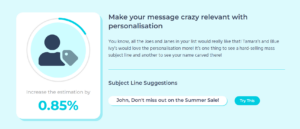
4. Personalize your email content
Apart from starting the email with the subscriber’s name, you should also personalize the body content.
For instance, you can recommend relevant products based on their past purchase history or provide useful information about a product they are interested in.
Here, using marketing automation can be a great solution. For example, you can use Moosend to set up a successful drip campaign and offer weather-based recommendations through automated emails.
These direct emails will provide your audience with instant solutions, such as promoting coats and scarves during cold weather to solve a pain point. Plus, not many businesses send this type of email, so it’ll be something new and exciting for your customers.
Here’s an example by Argos:
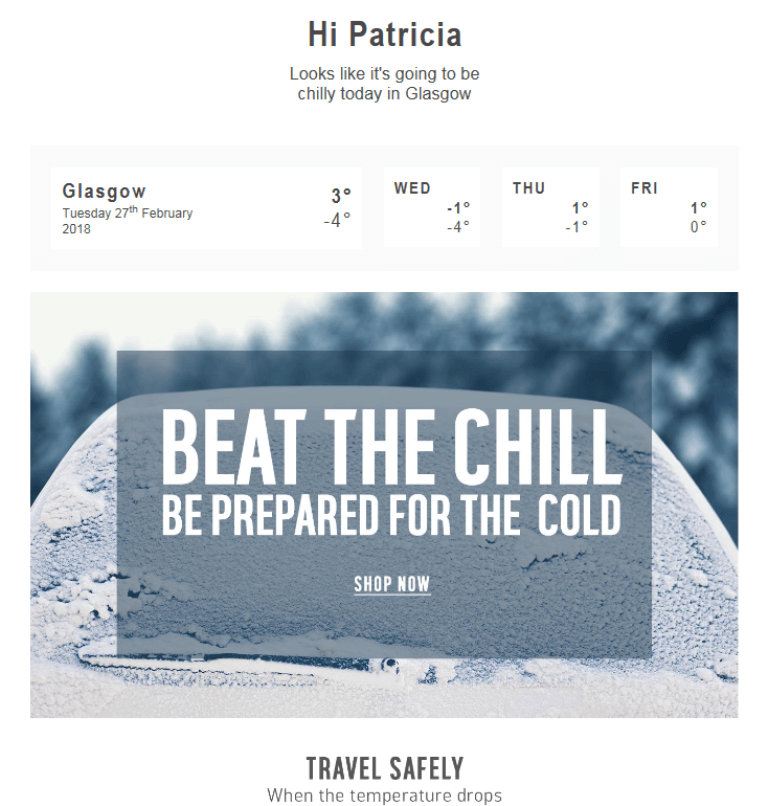
If you want to explore weather-based recommendations further, you can use Moosend’s workflow builder to set up a weather-based workflow and then craft a beautiful email campaign like Argos above.
5. Include a compelling call-to-action
Without a clear CTA, the subscribers won’t know what you expect from them and might not take any action.
However, you must be clear about your goal for a call to action to get the desired results. Is it promotional, transactional, or relational? Based on this, you can choose a relevant link for your CTA.
Here are some essential tips to keep in mind:
- Clarity and consistency: Make your CTA short, clear, and to the point. Use action verbs that tell the recipient exactly what to do (e.g., “Shop Now,” “Learn More,” “Sign Up”).
- Compelling copy: Use persuasive and compelling language that highlights the value the reader will receive (e.g., “Get Your Free Trial,” “Save 20% Today”).
- Urgency and scarcity: Encourage immediate action with urgent language (e.g., “Limited Time Offer,” “Only a Few Left,” “Act Now”).
- Visibility: Use contrasting colors, larger fonts, or buttons to draw attention.
- Placement: Position the CTA strategically within the email, ideally above the fold or at the end of a section.
- Design: Keep the CTA consistent with the overall design and message of the email to maintain a cohesive look and feel.
- Multiple CTAs: Add multiple CTAs for different actions (e.g., “Read More,” “Download Guide”), but prioritize one primary CTA to avoid overwhelming the reader.
- Optimization: A/B test different CTAs to see which ones perform better, experimenting with copy, design, placement, and color.
6. A/B test your campaigns
Building a successful email marketing campaign involves a lot of trial and error. That’s why it’s important to use A/B testing to determine what works and what doesn’t.
Moreover, you can use A/B testing to compare general email marketing campaigns with direct email campaigns. As a result, you’ll know for sure which type of email campaign is more effective in your case.
Platforms like Moosend will provide you with the right marketing tools to run your tests seamlessly. You can choose everything from the email list and subject line to the design and send time.
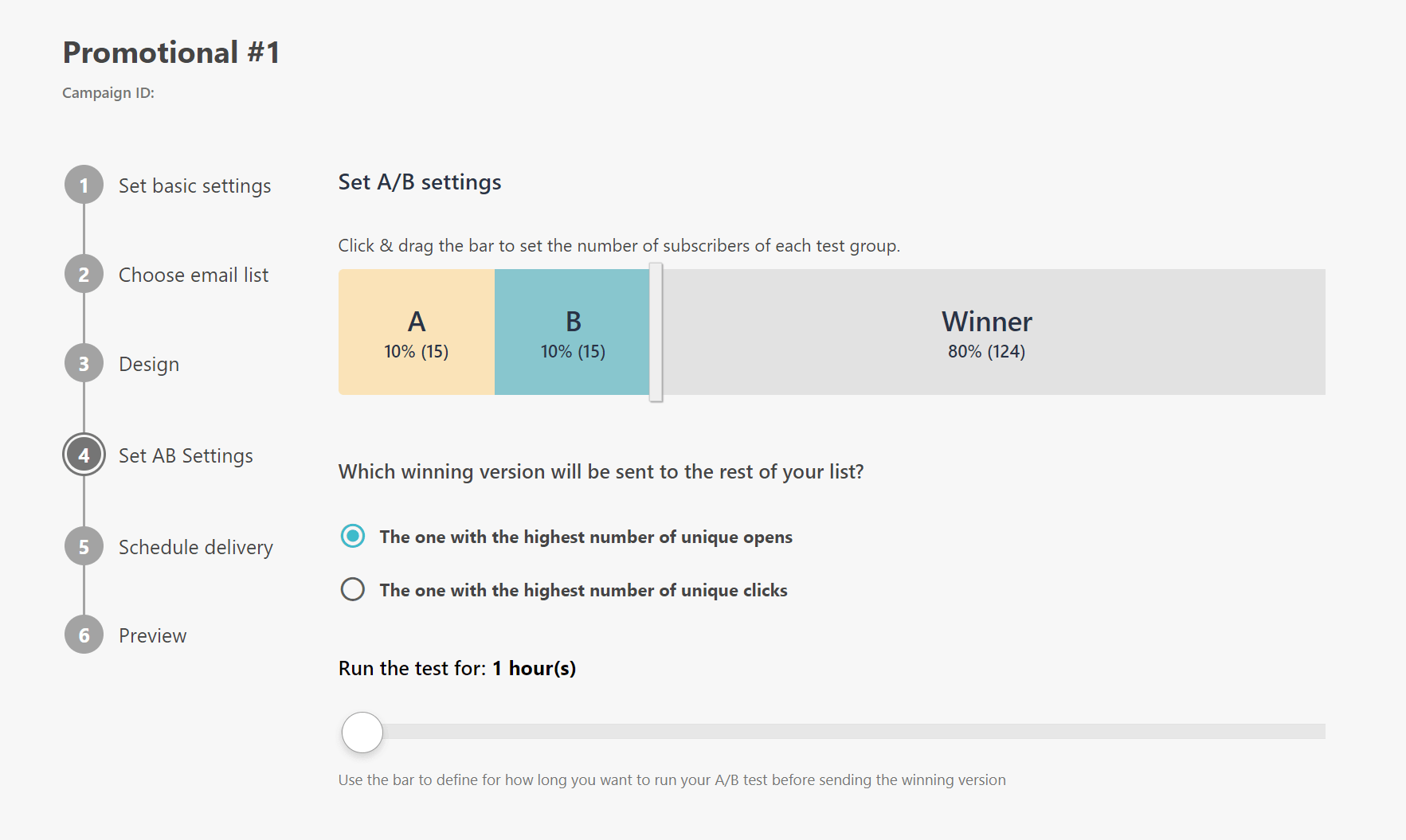
Want to see the full potential of A/B testing? Sign up for a Moosend account and try the split testing features yourself.
Further reading: Learn more about campaign optimization in our comprehensive A/B testing emails guide.
7. Track email performance
Now, once your direct email campaign is up and running, you should track and analyze performance metrics, like open rate and conversion rate, to identify strengths and weaknesses.
You can use email tracking software to monitor these performance metrics. Then, you can take advantage of your collected data to optimize your future direct email campaigns.
But before you can do that, you should learn how to measure the success of your campaigns.
How to Measure the Success of a Direct Email Marketing Campaign
When it comes to measuring the success of a direct email marketing campaign, some of the most common performance metrics you can track are:
Delivery rate
This rate indicates how many of your emails reached your subscribers’ inboxes.
How to calculate: It’s simple, you divide the number of bounces by the total emails sent. Then you multiply the result by 100.
Open rate
This metric shows you how many recipients opened your email.
How to calculate: Divide the number of opened emails by the number of emails sent and then multiply it by 100.
Click-through rate
This metric indicates how often a recipient interacts with your email through clicks.
How to calculate: To measure this, you divide the total number of clicks received by your email by the number of subscribers you sent it to. Then, you multiply the value by 100.
Conversion rate
This is the most important metric you should monitor because it indicates how many recipients took the desired action (e.g., sign up for something or make a purchase).
How to calculate: To calculate this metric, divide the number of subscribers who took the action by the number of emails sent and multiply the result by 100.
How to Tell if Your Campaign Is Profitable
Once the campaign is over, you can calculate the return on investment (ROI) of your campaign. Simply subtract the campaign gains from the total campaign costs. Then divide the result by the total campaign costs. Finally, multiply by 100.
Based on your email marketing ROI, you can safely determine how profitable and cost-effective your marketing efforts have been.
If the outcome is not as good as expected, you can optimize your future email marketing strategy. In addition, you can combine email marketing with other marketing channels for even better results.
Now that you know the basics, look at some of the best practices you should follow to increase your campaign’s success.
Direct Email Marketing Best Practices
If you want to maximize the results of your campaigns, you should also implement some email marketing best practices.
Here are some top choices but remember there are many more you can choose from.
- Include visuals in your emails: High-quality visuals are very useful for grabbing the attention of your subscribers. However, be careful not to include too many visuals, as this can have the opposite effect.
- Be GDPR compliant: This means choosing trustworthy email service providers and giving your subscribers the option to opt in and opt out regarding data collection and processing.
- Offer recipients the option to unsubscribe: Of course, nobody wants to lose prospects, but if a user is no longer interested in your products, you’re just wasting your marketing efforts on them. Thus, it’s better to have a clean email list.
- Use email automation: You save a lot of time by creating automated workflows for sending welcome emails, abandoned cart emails, and more.
Set Up Your Next Direct Email Marketing Campaign
As you can see, direct email marketing is a very effective marketing strategy, so there’s no reason not to try it.
However, setting up a direct email marketing campaign can be very time-consuming.
Therefore, we recommend using a comprehensive email marketing service that offers personalization, segmentation, automation, and tracking features to make your life easier.
To get started with direct email marketing, you can follow the above tips to create your first campaigns.
If you need a user-friendly tool to help you with personalization and offer you pre-made email templates to save time and streamline your email marketing efforts, you can sign up for a Moosend account today.
Frequently Asked Questions
Here are some of the most common questions about direct email marketing.
1. Is direct email marketing better than social media marketing?
It depends on your marketing goals. If you want to boost conversions, direct email marketing is a better option. However, social media marketing is the way to go if you want to expand your reach and take advantage of paid advertising.
2. Can you integrate direct email marketing with social media marketing?
Yes, you can integrate direct email marketing with social media marketing. More than that, it’s advisable to do so. After all, social media channels can help you grow your email list.
3. Is direct email marketing expensive?
Direct email marketing is not expensive, particularly if you manage it yourself. Of course, costs vary depending on various factors like the campaign size, the volume of emails, the marketing automation tool used, etc.
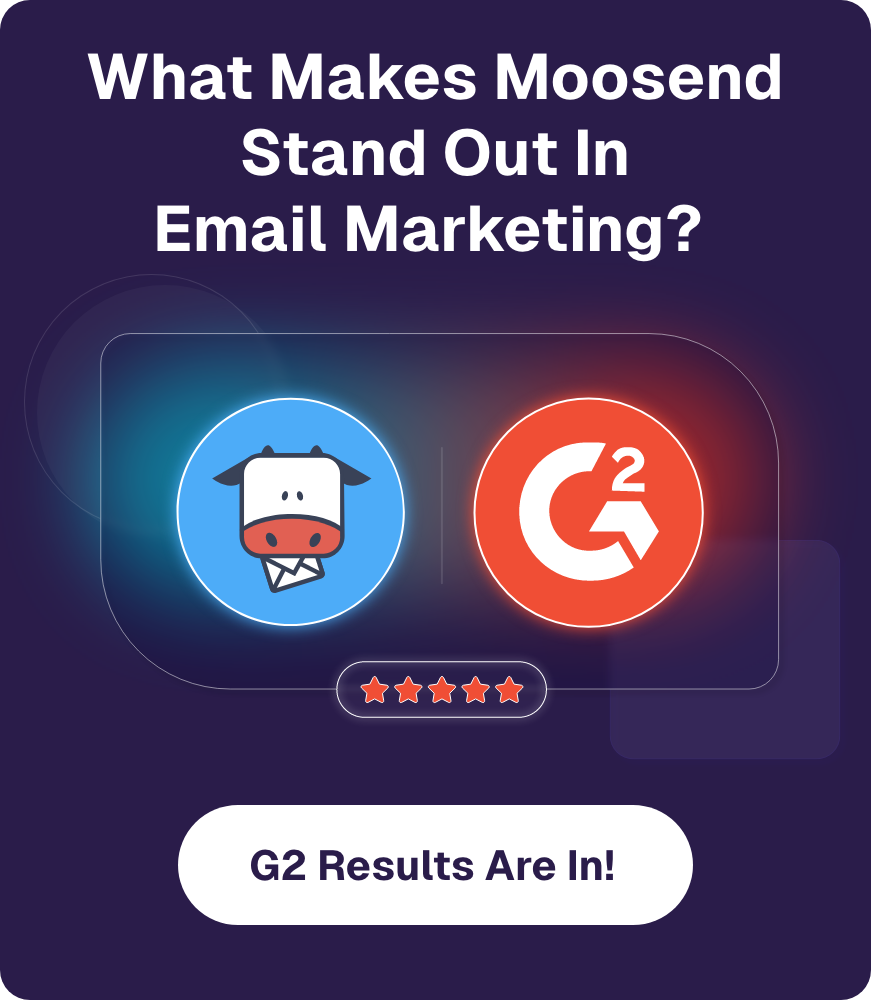


 Published by
Published by

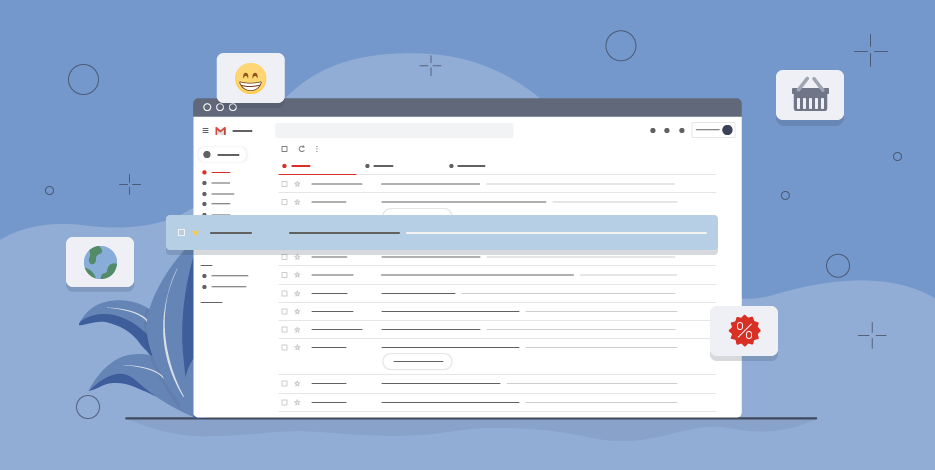
 Published by
Published by